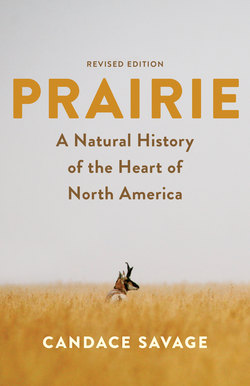Читать книгу Prairie - Candace Savage - Страница 4
На сайте Литреса книга снята с продажи.
ОглавлениеPREFACE
It may be that when we no longer know what to do we have come to our real work
and that when we no longer know which way to go we have begun our real journey.
WENDELL BERRY, STANDING BY WORDS, 1983
DAY IN AND day out, we are confronted by news of impending disaster. • “Twelve Years to Limit Climate-Change Catastrophe” • “Warning of ‘Ecological Armageddon’ after Plunge in Insect Numbers” • “World’s Food Supply under ‘Severe Threat’ from Biodiversity Loss.” Each fresh pronouncement strikes a deeper tone of despair, until our ears are ringing with the clamor of doomsday bells. No wonder so many of us are stressed out and fearful. No wonder we often feel grief-stricken, angry, bewildered: overwhelmed.
Meanwhile, in my backyard in Saskatoon, Saskatchewan, on the northern edge of the great North American plains, three whorls of prairie crocuses, or pasque flowers, are pushing their fuzzy noses through the half-frozen earth for the first time since the prairie was torn up to make way for my house, ninety-odd years ago. The plants are there because two of my friends, Lisa and Renny Grilz, run a small business from their kitchen table, the Blazing Star Wildflower Seed Company. A few summers back, they collected crocus seeds along a soon-to-be-widened roadway, fingered them gently into pots—pointy ends barely covered, long plumes reaching up—and then tended the balky seedlings through two successive summers. I planted them out in my flower bed and crossed my fingers.
Last spring, our collective efforts were rewarded with a cluster of silky, mauve flowers and a harvest of feathery seeds; this year, the roots have sent up a dozen eager buds. Each of them offers a lesson in hope and resilience.
The prairies, the magnificent grasslands that sprawl across the heart of North America, have taken a ferocious beating in the last couple of hundred years, and the challenges that beset the Earth as a whole all echo loudly here. Climate chaos is already desynchronizing the emergence of butterflies and blossoms, and delivering alternate challenges of flooding and drought. Populations of grassland birds are in freefall, suffering the steepest and most persistent losses of any habitat group on the continent, decreasing by almost 60 percent in the last fifty years. Ten-thousand-year-old prairie continues to be torn up, replaced by cropland, coal mines, oil fields, and urban development.
Against this darkness, I offer you three crocus plants in a backyard. And I agree: as a response to environmental calamity, this is a woeful response. But what if those hopeful buds are just a beginning? What if, around them, we were to set the garden ablaze with prairie coneflowers, three-flowered avens, wild bergamot, giant hyssop, and buffalo beans? Let’s send unruly outbursts of cleome, or stinking clover, through the gate and onto the boulevard, where they’ll meet and mingle with a buzz-fest of bumblebees. Just for fun, we’ll add neat labels beside the plantings out front, where the mangy lawn used to be, so that passersby will be inspired to begin restoring the prairie’s wild beauty around their own dwellings.
And through this act of care and community, we may find that our minds begin to wander beyond their usual limits to the special places, near and far, where natural grasslands still survive, comparatively unharmed. Places where a shining wind ripples through stands of little bluestem and porcupine grass. Where the rising calls of curlews slice cleanly through the air. Where crocus buds push through the icy ground without aid from human hands. Merely to think of these light-filled spaces lifts our spirits and calms our thoughts. Despair is a useless emotion, and panic (though understandable) cannot help us find our way. It is Out There, in what Wendell Berry once described as “the peace of wild things,” that we will find the courage to take the steps, large and small, that we need to be taking.
Here’s what we already know: • We need to protect the remaining wild prairie and its unique animals and plants. • We need to restore the tilth and depth of prairie soils, not only to nourish ourselves but also to modulate the worst extremes of a changing climate. • We need to salvage, plant, restore, connect, lobby, and speak up.
At the same time, we need to make time for the pleasure of nurturing our own wild selves, by cultivating hope and renewing our capacity for joy and wonder. And that’s where this book comes in. Prairie: A Natural History of the Heart of North America provides a comprehensive overview of grassland ecology and conservation, with a solid grounding in up-to-the-minute science. But this book is also a celebration, an extended love song to one of the world’s largest and most remarkable ecosystems. Often overlooked and under-appreciated, the Great Plains Grasslands are an unbounded landscape of surprise and mystery. It’s time to go exploring!
